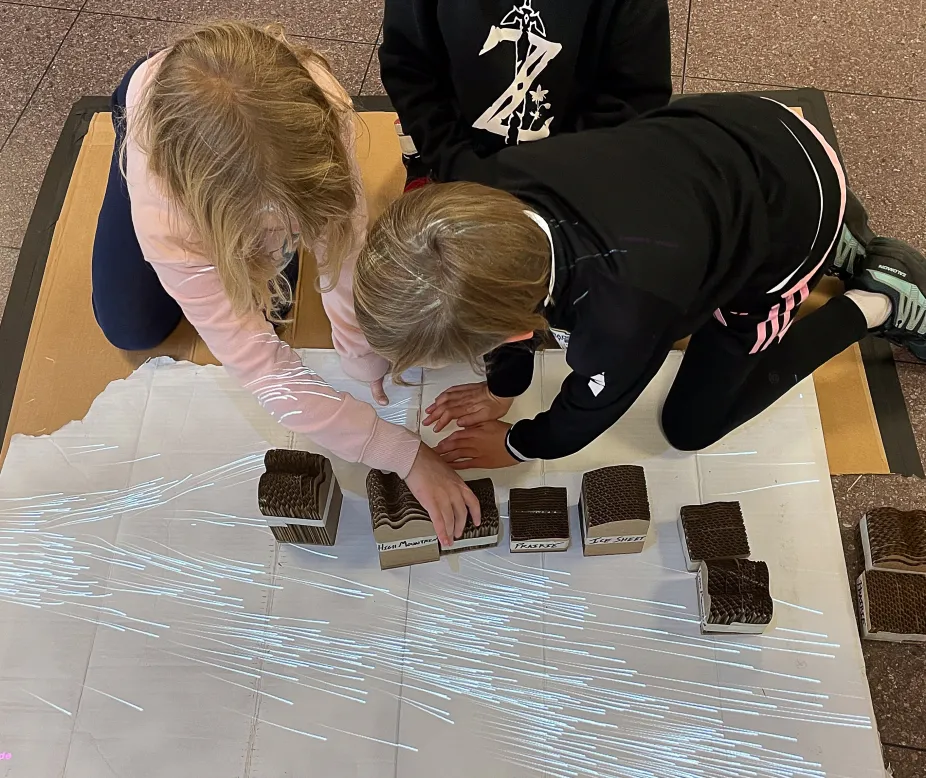Winds Through Time
About the Exhibit
Winds Through Time is an interactive exhibit installation that allows visitors to see changes in wind and Earth system variability based on real-time changes in topography through the positioning of blocks. Visitors can move blocks of different colors and heights (representing ice sheets and mountains), and the interactive displays the effects of these changes in the topography on wind via a projection. The patterns in the wind flow indicate the paths along which storms develop and where precipitation occurs over timescales of decades, centuries, and longer. The locations of the ice sheets or mountains have visible impacts on the Earth system.
How Does it Work?
Visitors move three types of custom-designed blocks representing ice sheets, tall mountains, and low mountains across a map of North America to recreate the ice sheet that once covered the continent. As the visitor moves these blocks, a sensor observes the changes and shifts the general direction of the wind blowing from the Pacific Ocean across North America. A projector then displays the wind displacement in response to the visitor’s actions.
The exhibit team designed and constructed the blocks for the mountains and ice sheets using gridded global Earth system model output as inspiration. A depth camera reads the table top and sends a real-time depth image to the simulation. The code for the wind simulation contains four main parts: a field of “repelling” forces that represent the mountains and ice sheets, the particles that represent wind movements, a wind force that moves particles across the simulation but flows away from the mountains, and a storm that also follows the forces across the table top.
Support
Winds Through Time was funded by the U.S. National Science Foundation (NSF) P2C2 (award #2102984) and developed collaboratively with the University of Colorado Alliance for Technology, Learning, and Society (ATLAS) Institute, the National Oceanic and Atmospheric Administration (NOAA) Physical Science Laboratory, and the UCAR Center for Science Education.
History of the Project
The Winds Through Time exhibit was a unique outreach component of the NSF-funded research project: An integrated model-proxy approach to understanding Western U.S. hydroclimate change since the last glacial period. Undergraduate and graduate students from the University of Colorado Boulder’s ATLAS Institute were asked to design an exhibit for the NSF National Center for Atmospheric Research (NSF NCAR) Mesa Lab Visitor Center that brought to life how massive ice sheets helped shape North America’s wind patterns and influenced the weather and the Earth system during the last Ice Age. Ultimately, the student project that created a tangible user interface to playfully learn about Ice Age environmental conditions was selected to become a permanent exhibit at the Mesa Lab in Boulder, Colorado.

Students prototyping the Winds Through Time exhibit at the Mesa Lab.
UCAR
Ph.D. candidate David Hunter, who developed the exhibit’s code and concept during the ATLAS Institute class, worked with the team to refine the exhibit further to meet the requirements of the scientists and the Mesa Lab staff. Feedback received from students and adults during prototyping further refined the exhibit design.
This highly collaborative project team included an interdisciplinary group of faculty, scientists, museum educators, education specialists, and exhibit designers.
Exhibit Team
University of Colorado Boulder (CU)
- David Hunter (Ph.D. student, The ATLAS Institute)
- Kristopher Karnauskas (Principal Investigator, Cooperative Institute for Research in Environmental Sciences (CIRES), Atmospheric and Oceanic Sciences (ATOC))
- Wayne Seltzer (The ATLAS Institute)
- Mark Gross (The ATLAS Institute)
- Ann Eisenberg (Institute of Cognitive Science/The ATLAS Institute)
- Jon Brumm (The ATLAS Institute)
- Pablo Botin (Ph.D. student, Simulation Development)
UCAR
- Becca Hatheway (Principal Investigator, UCAR Center for Science Education)
- Amy Stevermer (The COMET Program & UCAR Center for Science Education)
- Emily Snode-Brenneman (UCAR Center for Science Education)
- Sharon Clark (UCAR Center for Science Education)
- Emma Hagen (UCAR Center for Science Education)
- Katie Wolfson (UCAR Center for Science Education)
NOAA
- Dillon Amaya (Principal Investigator, NOAA Physical Sciences Laboratory)
Woods Hole Oceanographic Institution
- Alan Seltzer (Principal Investigator, Marine Chemistry & Geochemistry)
Exhibit Designers and Advisors
- Eddie Goldstein (Science Communication Advisor and Museum Science Educator)
- Condit Exhibits (final exhibit design and fabrication)
This exhibit was installed on August 6, 2024.